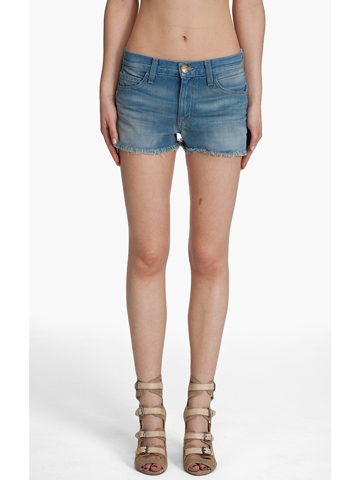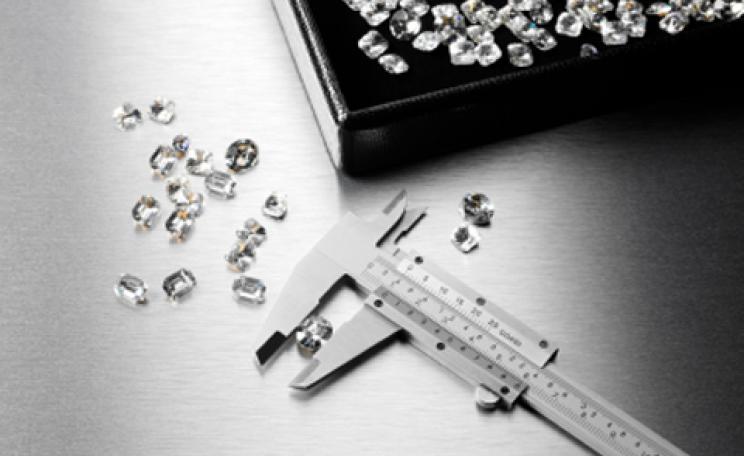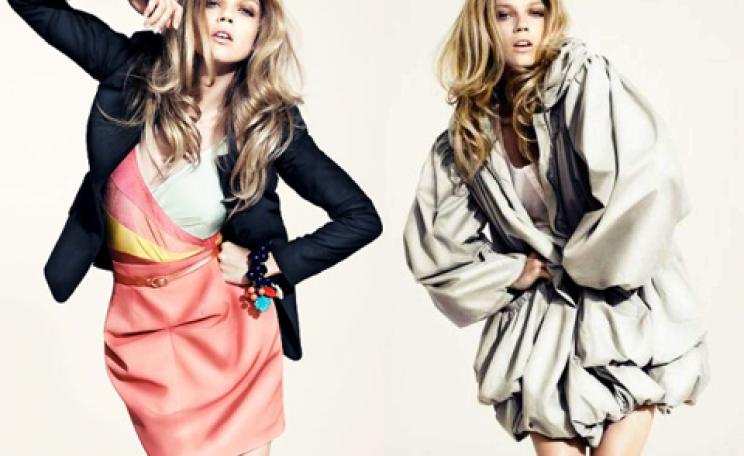We live in a throw away world. A world where cheap products flood the shops each season designed to look good and last – but only for a few months. The average person sends 30kg of old clothes to landfill every year where they slowly start to rot, stink and produce methane; one of the most potent greenhouse gases. Add to that the harmful dyes used in the manufacturing process and the dire working conditions that many textile labourers face and suddenly the environmental price of cheap clothes is very high indeed. The solution? To recycle, upcycle and convert your clothes. Here's how to do it.
Recycle
Create a whole new wardrobe from the same old outfits. Think like a stylist and mix and match by layering, clashing or by combining smart with casual. If you find yourself lacking in sartorial flair, newspapers and magazines are brilliant places to get ideas and inspiration from. Clever accessorising is another way to instantly update your look. Scarves, belts, bangles, bags and shoes are great for giving new life to a tired outfit or creating a completely new look for a well used dress. Hats and headscarves will draw the eye up while leggings and funky tights will draw attention to good legs. You could also make an antique brooch or cluster of badges the main feature.
 Cheap jewellery is still part of the disposable culture and is often made from harmful, polluting substances. So avoid the bargain basement plastic and metal accessories from high street stores and supermarkets and make friends with your local charity and vintage shops instead. Better still, trade jewellery with your friends. What you wear on your face can also change the look of an outfit. Lipsticks can contrast or compliment while you can create drama with a vibrant eye shadow. You could also add some Eastern inspiration with bhindis and stick on jewels. For the more daring, facial art could be the answer. Delicate painted flowers can be worn on the temples or Moroccan Berber symbols can adorn the cheekbones. Sticking to an Eastern theme, why not find a henna artist who can decorate your hands, feets, legs, arms and chest?
Cheap jewellery is still part of the disposable culture and is often made from harmful, polluting substances. So avoid the bargain basement plastic and metal accessories from high street stores and supermarkets and make friends with your local charity and vintage shops instead. Better still, trade jewellery with your friends. What you wear on your face can also change the look of an outfit. Lipsticks can contrast or compliment while you can create drama with a vibrant eye shadow. You could also add some Eastern inspiration with bhindis and stick on jewels. For the more daring, facial art could be the answer. Delicate painted flowers can be worn on the temples or Moroccan Berber symbols can adorn the cheekbones. Sticking to an Eastern theme, why not find a henna artist who can decorate your hands, feets, legs, arms and chest?
Upcycle
When you’ve run out of cupboard combinations, try upcycling your clothes. Upcycling is eco-speak for the process of converting waste products into something of value. Instead of throwing a decent pair of jeans away, turn them into cut off shorts, add some colourful tights and get another season or two out of them. And don’t worry if you can't sew, says Paula Kirkwood, head of design of fashion recycling charity, TRAIDremade. ‘Using techniques such as cutting, ripping and dyeing, it’s easy to update clothing even if you have never been near a sewing machine.' All you need is a decent pair of scissors.
 Try these 10 ways to upcycle your clothes:
Try these 10 ways to upcycle your clothes:
• Make an old t-shirt into a tank top by cutting off the sleeves
• Cut the neck off an old jumper or long sleeved t-shirt to create a scoop neck or off the shoulder number
• Shorten trousers into Capri style pants
• Make hybrid clothes by sewing two damaged pieces together
• Transform a t-shirt into a halter by removing sleeves, collar and making the neck strings from the excess fabric
• Chop a dress in half to create a new top
• Wear old neckties as belts a la Liv Tyler
• Transform dull pieces into something fabulously on-trend by dyeing them
• Add fake fur trims to collars or cuffs
• Add buckles, sequins, stars, lace flowers, feathers and stick on jewels to old clothes or a pair of simple flats
Damaged clothes needn’t spend their final days in landfill either. Patch them up with contrasting fabrics or edge frayed hems with colourful silk ribbons. If you fear the needle, there are plenty of experienced seamstresses who can work their magic on a tired or damaged piece.
Convert
What if there was a way to solve your wardrobe dilemmas with just one piece? Well, a burgeoning group of designers are trying to minimise their ecological footprint and cut down on fashion waste by making a clothes that can be worn in a multitude of ways; cutting down on the need for endless dresses, tops and trousers in the process. The Limitless Dress by Scandinavian designer Emami, is just one dress but there are 30 different ways to wear it. Emami are aware of the effect clothes manufacturing has on the environment. ‘Therefore we do what we can to protect the earth,' they say. Their stance is also anti-consumerist; compromising their own profits by making one multipurpose piece designed to last.
 New Yorker Eliza Starbuck, is another designer disgusted by the disposable culture that permeates the fashion industry. So much so that she designed a multifunctional dress for her friend Sheena Matheiken to wear every day for one full year. ‘It takes such a huge amount of human energy and textile fibres, dyes, and chemicals to create even poor-quality clothes,’ she says. ‘It’s throwaway fashion or "trashion"'. The dress was designed to be worn three ways and with it, Starbuck and Matheiken created 365 different looks using vintage and second hand accessories, hats, shoes, belts and scarves. They even received jewellery donations from fellow eco-fashionistas following the progress online.
New Yorker Eliza Starbuck, is another designer disgusted by the disposable culture that permeates the fashion industry. So much so that she designed a multifunctional dress for her friend Sheena Matheiken to wear every day for one full year. ‘It takes such a huge amount of human energy and textile fibres, dyes, and chemicals to create even poor-quality clothes,’ she says. ‘It’s throwaway fashion or "trashion"'. The dress was designed to be worn three ways and with it, Starbuck and Matheiken created 365 different looks using vintage and second hand accessories, hats, shoes, belts and scarves. They even received jewellery donations from fellow eco-fashionistas following the progress online.
The big players in the mainstream fashion industry may appear slow to change their ways but there are some designers speaking out. Project Catwalk host and designer Ben De Lisi, whose designs have been worn Kate Winslet and Helena Bonham Carter, says that ‘it’s shocking how many clothes we throw away each year’ and has been involved in clothes recycling projects across Britain. Even Diane von Furstenberg is converting her clothes and earlier this year launched the Kalara Convertible Tank Dress and Dacia Convertible Skirt/Dress.
While the fashion industry creates an obscene amount of waste, we don’t have to be part of that detrimental chain of cheap over-supply and demand. As consumers we have the power to influence by not buying into the latest look. As designers like Emami and Eliza Starbuck have proved, you can be brave and create your own style from what you've already got. It's not anti-fashion but anti-trashion.
| READ MORE... | |
 |
GREEN LIVING Safia Minney: fashion’s impact on the earth In an exclusive extract from her new book - Naked Fashion - the People Tree founder looks at the environmental damage caused by modern fashion – and sketches out a radical new way forward |
 |
GREEN LIVING Craftsmanship: a dying art? As London Fashion Week kicks off, Lida Hujic looks at the reasons behind the decline of British craftmanship and asks if we're in danger of losing it altogether |
 |
GREEN LIVING The new north: why Scandinavia is leading the world in eco-design The Nordic flair for design has taken eco-fashion to new heights and is setting an example for the rest of the world to follow, says Ruth Styles |
 |
GREEN LIVING Specs appeal: the eco-friendly glasses you’ll want to wear Specs might be the accessory du jour but metal and plastic glasses come at a heavy cost to the planet. Luckily, Herrlicht’s chic wooden frames are the perfect alternative |
 |
GREEN LIVING Ask the Ecologist: cotton, hemp and bamboo - which is the green choice? Green Living Editor Ruth Styles answers your eco-lifestyle dilemmas. This week, we're talking textiles |








